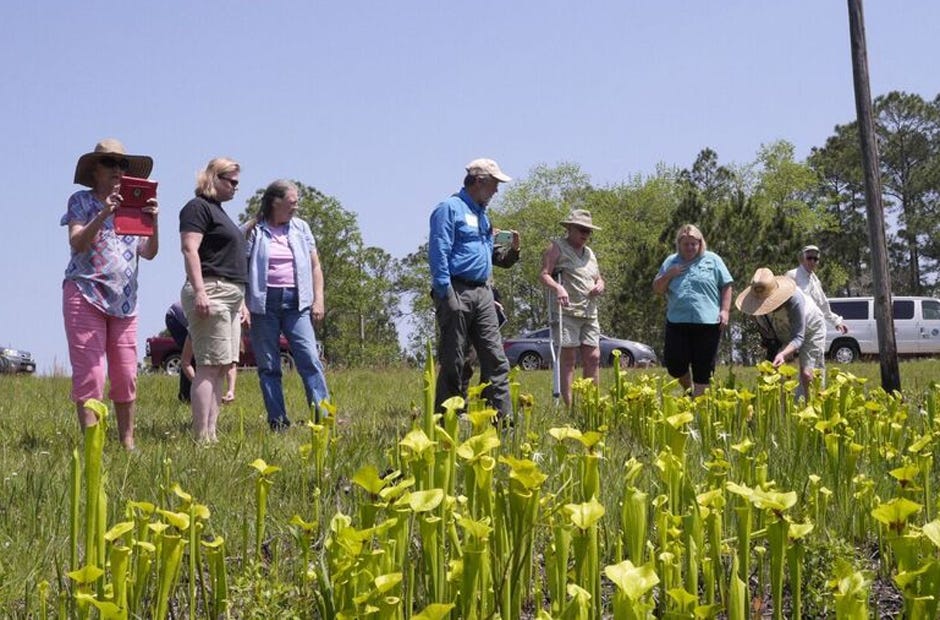![Florida Master Naturalist Program participants viewed a field with rare pitcher plants recently in Northwest Florida. [Eric Tiu]](http://127.0.0.1/wordpress/wp-content/uploads/2022/01/ghows-DA-4fde5992-03d5-063e-e053-0100007f06ed-2cbb703c.jpeg)
The mission of the Florida Master Naturalist Program, which is taught through the local Extension office, is to promote awareness, understanding, and respect of Florida's natural world among Florida's citizens. The program whets the appetite of students for information on local flora and fauna and often leads to additional research outside the class.
In spring 2017, students took the Freshwater Systems Module in Okaloosa and Walton counties. One student mentioned that she had a large patch of yellow trumpet-leaf pitcher plants growing on her farm, and as many in the class were interested in seeing pitcher plants in bloom in the wetland areas that they were studying; they took an impromptu field trip.
Florida is home to six species of pitcher plants (family: Sarraceniaceae). Five can be found in Okaloosa and Walton counties in the Florida Panhandle: these include the Yellow trumpet, Whitetop, Parrot, Gulf Purple and Gulf Coast Redflower.
Pitcher plants are native perennials that have adapted to living in a habitat that is nitrogen poor, acidic and at least seasonally saturated. These plants are rare and definitely worth seeking out to get a good look.
Pitcher plants have evolved with several adaptations to survive in their sometimes harsh habitats. They are carnivorous and trap insects to compensate for the nitrogen limiting soils where they live. The plants have modified hollow leaves that form tubes. The tubes are open at the top and often completely or partially covered by a specialized flap or hood, helping to reduce the amount of rain entering the tube.
The brightly colored hoods and tubes help attract prey, and often have a strong odor as well. The tubes are slick on the inside, with downward facing hairs, resulting in curious insects sliding to the bottom of the leaf where a small pool of water traps and drowns them. As the insect decomposes, the resulting nitrogen becomes available to the plant. You will often see ants, flies, wasps and bees caught in the pitcher traps.
The yellow trumpet-leaf pitcher plant is one of the largest species, with a yellowish-green tube and hood streaked with dark maroon splotches. The flowers have a musty smell. In Florida, this species is found in the northwest region from Leon County, west to Escambia County. Often, multiple species of pitcher plants can be found growing in the same area.
Protection of the pitcher plants and their habitats is important due to increasing loss of their unique habitats. Baseline surveys and continuing monitoring can help detect changes in pitcher plant populations.
Restoration efforts often include frequent prescribed burning in order to reduce surrounding hardwood species. Restoration of local hydrology may also help maintain and grow populations. Other threats include feral hogs and humans, as they both have negative impacts on pitcher plant populations. It is also important for the general public to be educated about these unique plants. Collecting pitcher plants in the wild is prohibited by law; however, plants can be purchased from reputable retailers. Following these recommendations will help to conserve these remarkable plants and their habitats.
Other threats include feral hogs and humans, as they both have negative impacts on pitcher plant populations. It is also important for the general public to be educated about these unique plants. Collecting pitcher plants in the wild is prohibited by law; however, plants can be purchased from reputable retailers.
Following these recommendations will help to conserve these remarkable plants and their habitats.
For more information, visit http://www.masternaturalist.ifas.ufl.edu or contact your local Extension office.
Laura Tiu is an agent at the University of Florida's Institute of Food and Agricultural Sciences Extension office in Crestview.




This article originally appeared on Crestview News Bulletin: Pitcher plants evolved to survive
